Oklahoma are not only the home of Native American Heritage they’re also a big home to a lot of frogs. Here, you get to see some amphibian friends that belong to the tree frog family, isn’t it amazing?
This large state is the birthplace of 13 tree frogs. All of them are unique and full of details. It’s such a treat if you can get to see them all. Surely such prospects interest you, doesn’t it? Well don’t worry, I’ll bring every information you need to know about the tree frogs in Oklahoma in the palm of your hand.
I plan to cover all the aspects starting from diet, and lifespan, to the predator of these frogs in broad detail.
So, let’s explore A to Z about these tree frogs. So what are these 13 tree frogs that I mentioned? I’ll introduce them to you shortly:
1. Gray tree frog
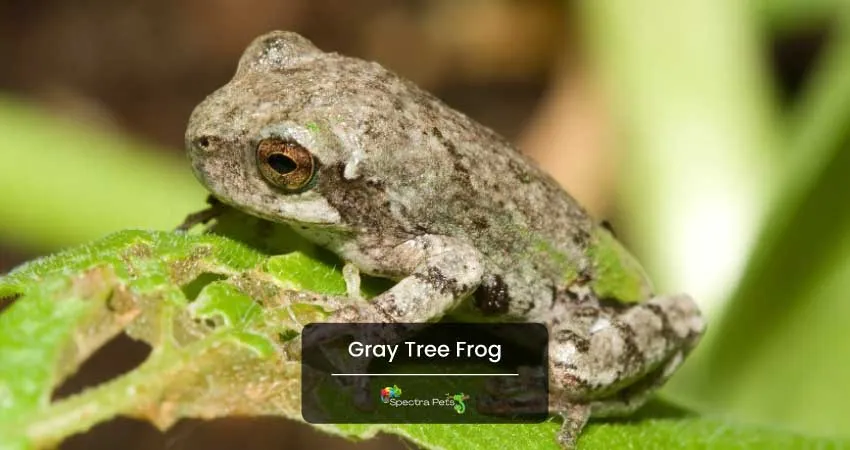
For the people of Oklahoma, it would be a frequent event to see these little buddies looking for their food. These guys have the ability to alter the skin shades that help them to survive in nature for a long duration.
Plus, their long lifespan of 7-9 years indicates that their chance of population decline is too low. This big head & bulgy eye frog is a good hunter that plays its part in the ecosystem by consuming varieties of insects like spiders, ants, beetles, etc.
They change the skin shade rapidly from green to brown, and brown to green depending on the background color. They spend a good amount of time resting high on trees.
In addition to that, on the ground, they like to hide inside tree holes, under rotten tree logs and fallen leaves. Places like agricultural land, the edge of mountain streams & swamps are their favorable habitat.
Moreover, the male emits a flute trill to bring the female closure to them. These species achieve sexual maturity at around 2 years old. From the start of the Spring season to the end of Summer, they continue their breeding journey.
When it comes to size, undoubtedly this 2.25″ frog is one of the big members of the entire Tree frog family. Their range is wide and also found in Texas, Ohio, Florida, and Kansas State.
2. Spring peeper
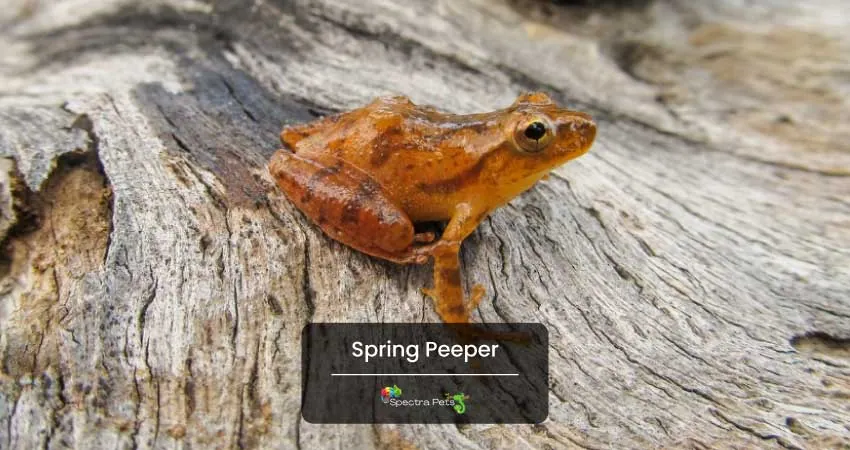
Spring peeper is renowned for its high-pitch call that feels like a peeping sound. Though they are nighttime eaters, it’s not uncommon for them to hunt during the early evening.
Plus, their skin color can be pink, light brown, reddish, tan, green, or gray. And the belly of this little frog is white or cream in color. These species have an X mark on their backside.
Moreover, this slender frog lives around 3-4 years in its natural habitat. When they become fully grown the size can be a maximum of 1.5″. They are top-notch climbers and their toepad, small size & lightweight help them to climb better.
Using the climbing tactics, they not only get on the tree but also dodge the hunter like raccoons, snakes, and birds of prey.
Anyone with little knowledge about frogs can tell the difference between a male & female spring peeper. The male is small & dark in color. On the other hand, females are big & have a light skin color. Right after reaching sexual maturity within the 1st year, they engage in mating in the closest April month. And the breeding period lasts till June.
Their diet is built upon small insects like ants, moths, flies, spiders, and beetles. During winter they don’t freak out & die, rather they go for long hibernation under the ground or under large tree logs.
Moreover, the natural habitat of this loud tree frog belongs to a wooded zone, grassy land, and lowland which are just a few meters distance from lakes, wetlands, ponds, and swamps.
Regarding population, this beautiful frog is listed as the least concerned amphibian. Along with Oklahoma, they are available in Pennsylvania, Florida, Texas, and Minnesota.
3. Blanchard’s cricket frog
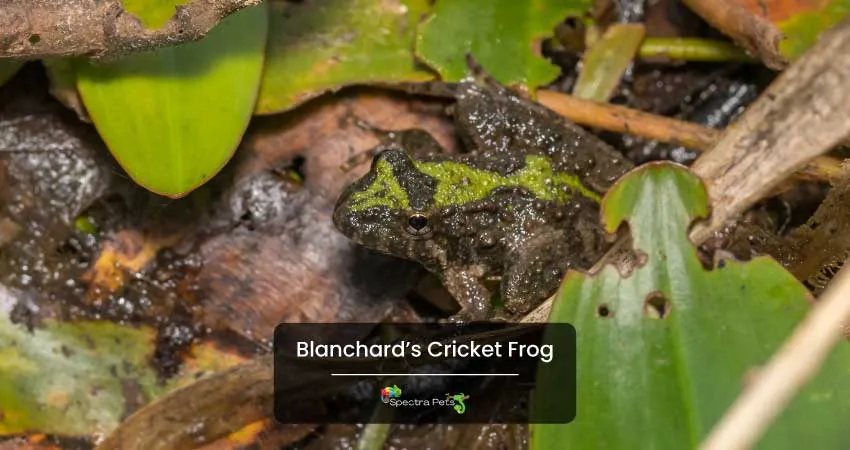
Despite being endangered in some states, the Blanchard’s cricket frog is abundant in Oklahoma. The range of these species is wide and found in Ohio, Michigan, Kansas, Minnesota, Texas, etc.
Regarding size, these frogs are no exception to other Hylidae members. When the food & climate does not help enough, they grow only 0.6″. With ample amounts of food consumption & the right climate will help them to grow a maximum of 1.5″.
Plus, they have a soft corner for aquatic plants so their habitat is marshes, lakesides, mud flats, sandy areas close to water, fens, and prairies.
They gain sexual maturity within the first year of birth. As soon as June arrives, the male starts emitting a call for the female. For mating, this smart creature chooses a slow-moving water zone or temporary pool.
This tree frog has two unique attributes which are not common at all. Unlike other species, they call at any moment whether it’s day or night. Another surprising nature is they remain active both day & night as the summer says hello!
When it comes to dealing with harsh freezing winters, these frogs lose the game. Around 5% of their overall population can survive the winter & continue the journey.
Any frog that’s blessed with olive green, brown, gray, or tan skin can camouflage itself to stay safe from predators. Adding to that, this intelligent creature jumps into the water whenever they feel unsafe because of high-level hunters.
Speaking of diet, they are good eaters that don’t show mercy to any small insects that fit their mouth.
4. American green tree frog
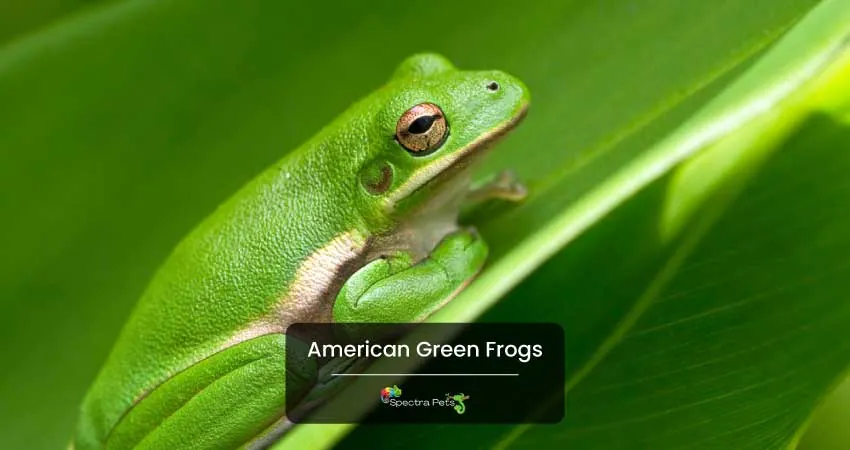
This bright colorful frog is one of the best climbers among all the Hylidae members that live in Oklahoma, Delaware, Texas, and Florida.
An adult amphibian can grow from 1.25-2.5″ in length. The size ratio of males & females is indifferent to other tree frogs, the female is bigger than the male. A male frog’s throat is designed with a vocal sac that inflates during the call.
Their name says all about their skin color which is bright green. However, their skin is brown, olive-green, lime green, or gray. Another vibrant skin mark is the white or yellow stripe that runs through the side of its body.
Similar to the majority of frogs, they like to live close to swamps, woodland, ponds, and lakes. The local people of Oklahoma will often see them in their backyard.
How does this amazing frog help the ecosystem? Well, their position in the food chain makes them crazy mosquito & fly eaters. Which ensures a nice balance in the ecosystem of Oklahoma.
These green fellas breed as soon as they reach their sexual maturity around 2 years. Right after that, the next Summer or Spring time, they will engage in breeding on their specific soot.
When the breeding season goes on, the male starts calling more & more. The most high frequency of calling would be on warm & humid nights. The female feels irresistible after hearing the male ‘queenk queenk’ call and gets into the breeding zone quickly.
Compared to other species, the 2-5 year average lifespan in the wild is much better.
Finally, their adaptations make their survival journey a smooth one. They can instantly change the dorsal color when there’s any change in the surrounding, their mood & the temperature.
5. Western chorus frog
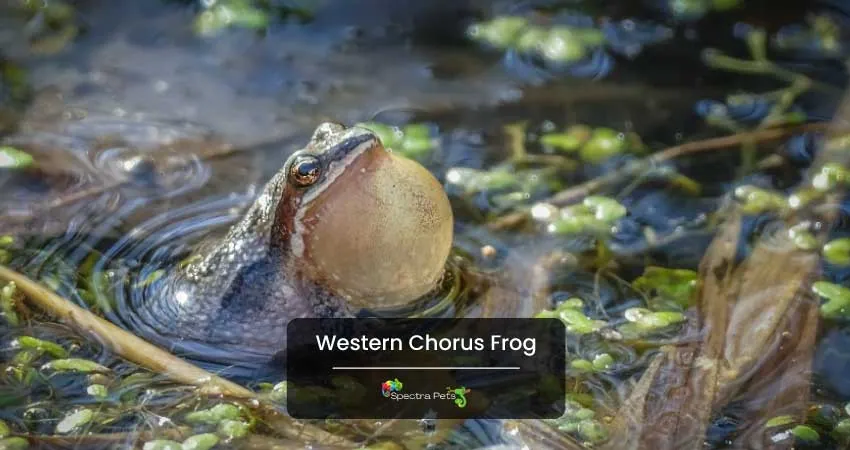
The earlier time they were known as Western chorus frogs & currently, the name became Midland chorus frog. This squishy little frog has a weakness for dense vegetation areas where they hide from predators.
Their desirable habitat is versatile which includes bog, agricultural land, swamps, grassy pools, marshes, meadows, riparian, sub-urban areas, and roadside ditches. For optimum growth, these species always require a temperate zone.
As they are gifted with skin colors like green, brown, and gray so they swiftly blend with surrounding colors. It helps them to evade the predator. Predators like raccoons, crayfish, minks, larger frogs, salamanders, snakes, etc.
Speaking of the size, the maximum length would be around 1.5″ if they get access to ample amounts of food & the right weather.
As for tree frogs, their 1-5 years lifespan is good. Thanks to the hibernation that keeps them going on the heart-freezing winter. Usually, they pass the winter by staying underground or hiding below tree logs.
Regarding sexual maturity, the male reaches it within 1 year and the female matures between 1-2 years old.
Moreover, a female can lay around 1400 eggs in a season. The breeding season lasts from March to June. These nocturnal amphibians start hunting for food right after the darkness arrives. The wide diet is packed with springtails, ants, midges, caterpillars, beetles, and snails.
Also, the webbed foot gives them immense support for swimming. You’ve probably already heard the Midland chorus frogs’ loud & repeated call if you’re from Oklahoma. The sound is like somebody running fingernails on a plastic comb.
6. Boreal chorus frog
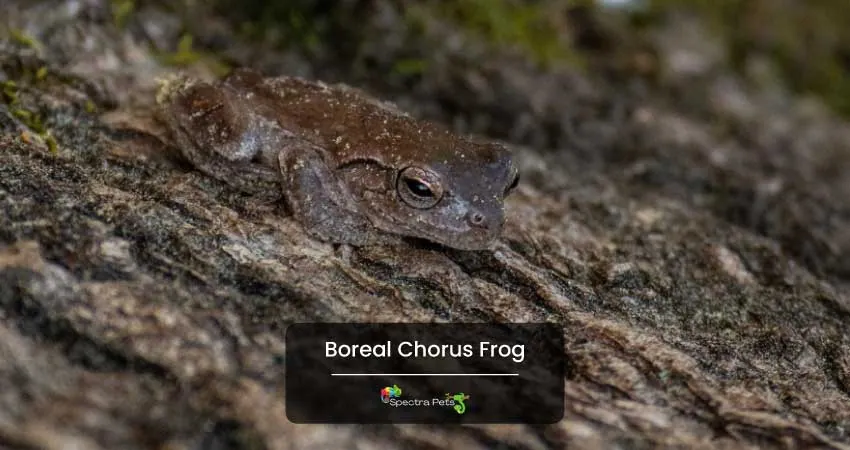
The Boreal Chorus Frog is a terrestrial frog that can be found in the boreal forests of Canada and the northern United States. Although climbing trees is no big deal for them, they stick to the ground.
They have an average size of about 0.75-1.5’’ inches, with males being smaller than females. Plus, the skin color of this frog is usually green, tan, red shades, gray, and brown, and has white-colored bellies. The key difference between male & female is that male is darker & females have lighter skin tones.
Anyone can clearly see the stripes on their back and also another dark stripe that runs through the side of this little fella’s body.
The breeding season for this species occurs during March & April. And the male calls out using a ‘creek creek’ sound to bring the female into the breeding spot. When it comes to lifespan, some frogs can make more than 3 years in the wild but the majority survive around 1-2 years.
Also, these species mate on land, and the female lays close to 1500 eggs that remain attached to the submerged aquatic plants. They pick flooded fields, roadside ditches, woodland ponds, and fishless farms as their breeding spot.
This species feeds primarily on insects such as beetles, mites, centipedes, and caterpillars as well as spiders and other small invertebrates by using its long tongue to catch prey at night while standing.
Furthermore, their hind legs provide them enormous support to jump to avoid a predator. These tiny frogs are listed as the least concern in many states of the USA.
When winter approaches, this magnificent creature hibernates, burrows itself deep inside the ground and turns its glucose level very high. Which function as an antifreeze element and appear again in the spring.
7. Western Bird’s voiced tree frog
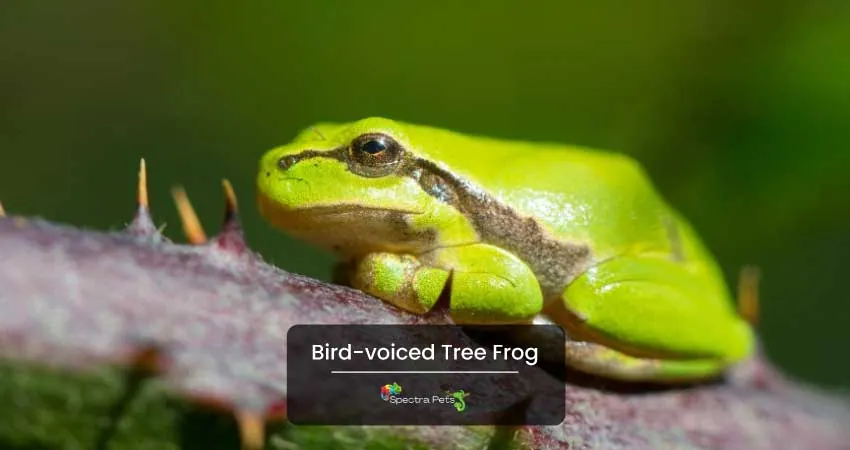
Throughout the USA, this tree frog is common. Their range includes Oklahoma, South Carolina, Mississippi, Arkansas, etc. Like many of its siblings from the Hylidae family, this one also loves to stay around moisture areas that are close to water. For example, flooded fields, large creeks, bald cypress, and wooden swamps.
Plus, the male & female species start making love from April- August. The Female lays eggs on water after the breeding session is completed.
Adding to that, the male generates a bird-like ‘wit wit wit’ fast calling sound to bring the female into the breeding surface. They repeat the trill 20 times per minute. In terms of size, the Western Bird Voiced Treefrog can reach the size of 1-1.75″.
Combining their amazing hunting skill & color-changing ability, they enjoy an average of 4 years of life in natural habitat. This nocturnal frog breaks their silence & keeps moving in searches of food like small invertebrates, ants, flies, and spiders.
Due to their arboreal nature, these colorful species spend a larger amount of time on trees & move to the ground prior to breeding season.
Furthermore, these warty skin species are available in green or gray, or brown colors. The bulging eyes of these amphibians are one of the key notable outer features. Depending on the situation, they can smoothly deceive any predator by altering the skin shades.
8. Cope’s gray tree frog
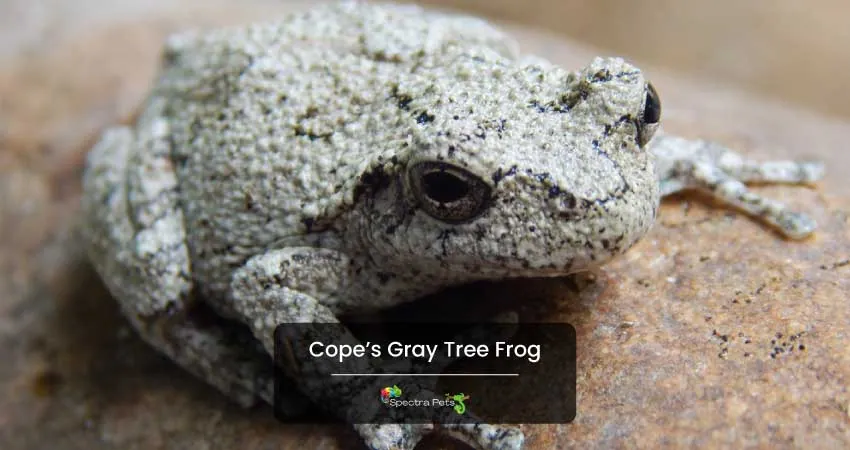
The Cope’s gray tree frog is native to the United States, where it can be found in Oklahoma, Florida, Texas, Minnesota, Wisconsin, Ohio, etc. They are found near water sources such as ponds, lakes, and rivers. It’s also common to see them in forests and grasslands.
Plus, the average lifespan of this frog is around 2.5 years in the wild and the maximum can be closer to 7 years old. The breeding season for the Cope’s gray tree frog occurs between spring and summer.
This species has a long lifespan because it spends most of its time hiding in its natural habitat. Due to their strong hibernation, they don’t feel the impact of blood-icing winter. They live on eating moths, plant lice, mites, spiders, etc.
Male tree frog produces high-pitch, slow, and raspy trill to ensure the female comes to the breeding zone. These calls can be heard from early evening until the early morning hours depending on location. It’s normal to hear them calling even without mating season.
Plus, the length of this species varies from 1.25-2 inches long with females being slightly larger than males. Cope’s gray tree frogs reach sexual maturity between1-2 years in the wild, but this can vary depending on location and individual factors.
Moreover, they breed in spring and summer. Their natural habitat is on the ground, but they can also climb into low-lying trees where they hide during the day.
Furthermore, the cope’s gray tree frog has a skin color that ranges from gray, pearl gray, gray-green, brown & green. They tend to change their skin color with the change of surrounding temperature to a dark or lighter color.
9. Cajun chorus frog
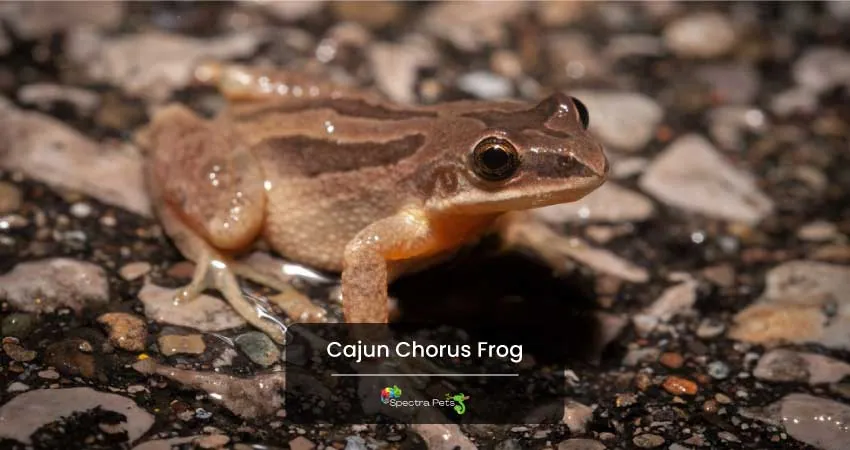
This amazing species is not limited to Oklahoma, they are available in Louisiana, Arkansas, Mississippi, and Texas. The breeding season of this amphibian begins in the last part of Winter & ends in early spring.
Plus, the male starts calling the female from breeding spots like flooded fields and corners of any grassy lake or ponds. The male emits a high-pitched trill that repeats 20 times a minute. Adding to that, the Sound of the trill is almost similar to someone raking a fingernail into a plastic comb.
Moreover, the natural habitat of this species includes swamps, marshes, wetlands & roadside ditches. This nocturnal critter is hard to see in daylight. While the mating season goes on they make the trill after evening. However, sometimes they call during the day.
Furthermore, the average lifespan of this creature is 1 year. Though some lucky ones survive up to 3 years. They are very little in size and the male grows around 1.25″. However, the females are much heavier plus bigger than the male frog.
Also, the skin is granular and mostly available in dark brown or black. Noticeable dark stripes are seen on their back. Usually, 3 long stripes are common, while some of them have rows of spots.
Speaking of diet, they live mainly feeding on tiny size arthropods and invertebrates. Though they belong to the tree frog family, this species roams around on the ground under leaf litter most of the time.
By eating up a significant amount of insects & spiders, they keep the ecosystem cycle balanced. People of the native area will listen to their calling echo at night time from the breeding ground.
Luckily this tree frog is the least concerned frog in Oklahoma & other states.
10. Strecker’s chorus frog
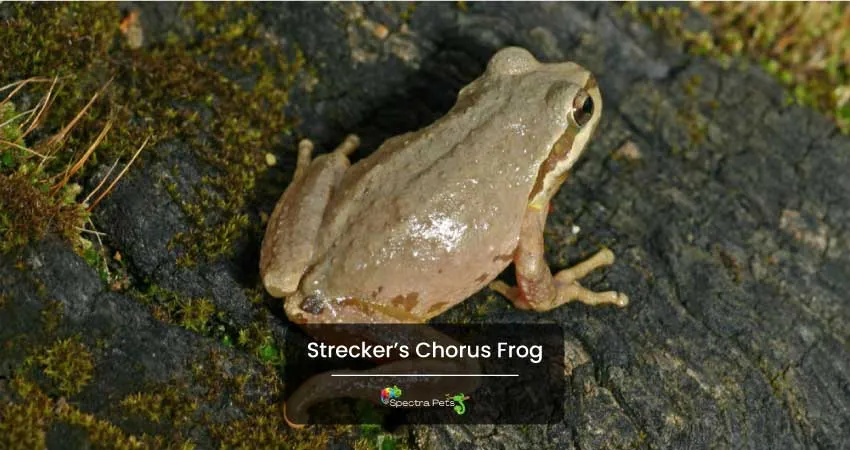
One of the well-known species that has a strong presence in Oklahoma, Kansas, Louisiana, Texas, etc. It’s not surprising to see them in both suburban and urban areas.
The Strecker’s chorus frog is a solitary animal that loves places loaded with lots of vegetation. Their nocturnal behavior encourages them to hunt when darkness begins.
Plus, they like to breed in temporary pools which are almost dry. This type of low-water zone gives them safety from any predators. Which eventually ensures lots of offspring are coming out at the end of the breeding season.
A combination of powerful legs, lightweight body & tiny size make them great climbers.Also, it assists them to run away from predators. Adding to that, the webbed feet make them top-notch swimmers. Predators like snapping turtles, raccoons, fish, etc hunt them in the wild.
Usually, this tree frog prefers wetland habitats like marshes, grassy pools, ditches, meadows, etc. Their highest length would be 1.5″ and they consume spiders, caterpillars, moths, springtails, snails, etc.
They have unique long stripes on the back and the skin hue can be brown, green, or gray. All of these colors give them huge benefits to achieving camouflage in nature.
While the average lifespan is 2 years, few can survive 3+ years. Passing the winter is not complex as it can go for a full hibernation mood under any tree log or ground.
Also, the breeding time is not too long but after every season around 250-600 frogs go into their natural habitat. When the mating season goes on, the throat of the male becomes darker.
In terms of size, the female is bigger like most other Hylidae members. And the weight can vary from 3-4 grams. The endangerment rating of these cute little amphibians is the least serious.
11. Northern cricket frog
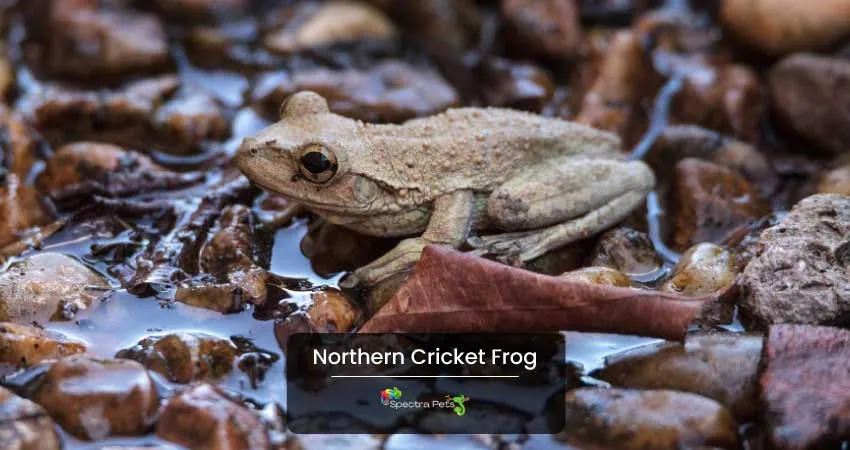
This frog is native to Pennsylvania, Texas, Oklahoma, and South Dakota. It makes a similar sound to that of a cricket bug. The highly dense vegetation place is particularly appealing to species of this group.
When it comes to adaptation, these little buddies know how to save themselves. The strong leg provides excellent support for jumping up to 3 feet. Along with that, it helps them to swim fast. Eventually, they evade their predator at a successful rate.
Plus, their food menu is filled with versatile insects like mosquitoes, beetles, flies, termites, and ants. They don’t grow more than 1.5″ in length.
Much like many Hylidae fellas, their skin shades are green, gray, black, brown, or yellow. They also have dark spots on their back.
By nature, these amphibians are terrestrial so they barely spend time on trees. They choose the edge of a sunny marsh, shallow water body, farm ponds, etc as their natural habitat.
Moreover, the cute round species become sexually mature within 1 year and don’t delay starting the breeding process during June- August. Mommy frog lays about 400 eggs after a successful mating.
While they are normally docile, male frogs become aggressive during the breeding season and heavily call out to the female. Sadly their average lifespan in the wild is only 1 year.
Lastly, they can change the warty skin color into different shades with the change in environmental conditions.
12. Spotted chorus frog
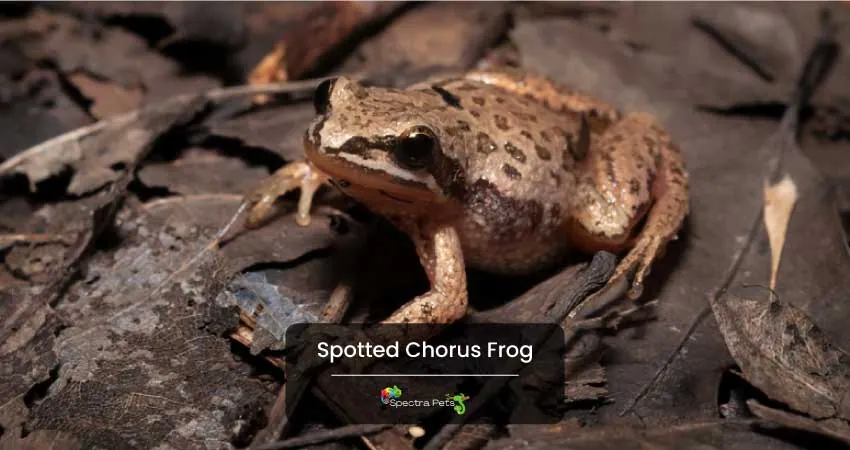
In many states, such as Oklahoma, Kansas, New Mexico, and Texas, this teeny-tiny tree frog has a stable population.
Plus, they put an immense impact on the ecosystem as they consume a large number of insects, flies, beetles, crickets, and moths. This way they keep the insect population under control.
Their habitat includes freshwater bodies, wetlands, marshes, temporary pools, shrubland, grassy pond, meadows, prairies and cattle tanks, etc. These species can have versatile skin colors like olive-green, gray, green and brown, etc. As usual, the female is larger than the male. This amphibian can reach up to 1.6″ in length while the weight varies from 3-4.2 grams.
In addition to that, this critter gets a 2-year average lifespan in the wild. They are gifted with hibernation ability so when winter comes they burrow themselves underground.
Moreover, their peak hour for breeding is the most rainfall time of Summer & Spring. The mommy frog lays around 1500 eggs in a season. Predators like salamanders, garter snakes, fish, and water snakes often hunt this beautiful frog.
Despite being a solitary animal, the male gathers in water pools and starts calling the female for mating. The male emits a high pitch call using the vocal cord & sac. The call feels to ears like a ‘wank wank’ call.
13. Upland chorus frog
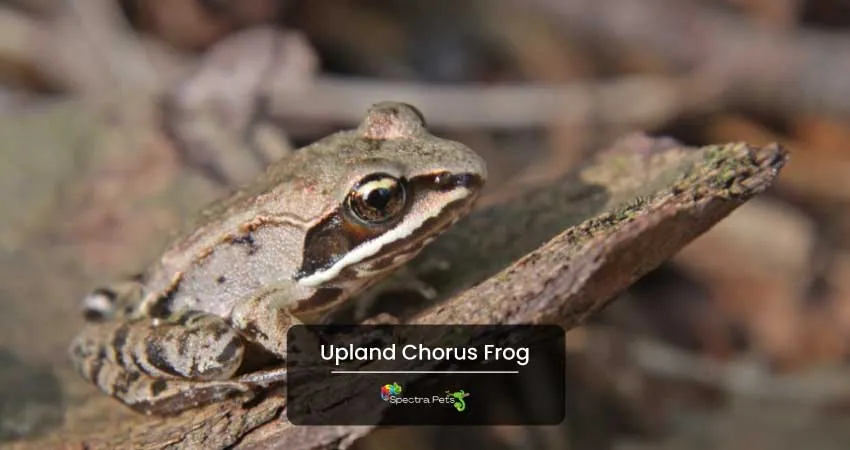
Upland chorus frogs are small, terrestrial amphibians that live in the southeastern United States like in Oklahoma, Florida, Alabama, Pennsylvania, and Florida, etc. They are found primarily in upland areas and can often be found under leaf litter on the forest floor.
Plus, the diet of this species consists mainly of insects, flies, moths, and other invertebrates that live on plants or water sources. They can adapt to a wide range of weather conditions including hot temperatures and dryness as well as cold temperatures and wetness.
In addition to that, they live in wet areas with lots of vegetation, including streams, ponds, marshes, and swamps. They can also be found in wooded areas and rocky outcroppings near water sources.
The breeding season for this species is from November- March. Males call to attract females and then tuck themselves into a small crevice or under a rock to guard their territory. The female lays her eggs on aquatic plants near the water.
Sexual maturity occurs within 1 year and after the breeding females lay around 1000 eggs. Male frogs are gifted with a vocal sac and they use it for grabbing the attention of females during mating time. This tiny creature can grow from 0.7-1.5’’ in length.
Moreover, the reddish brown, tan, gray, greenish-brown, and dark brown colors give them outstanding camouflage. As a result, they completely blend with the surroundings.
Final words
Whether you are a native of Oklahoma or other states, this article tried to give you all the fresh info about the native frog.
I know as an amphibian lover, it’s always an exciting experience to gather more & more data about frogs.
Hopefully, I was able to cover all the Tree frogs in Oklahoma from a new angle that would add new layers to your frog-watching eyes.
Tree Frogs Found in the Nearby States of Oklahoma:
